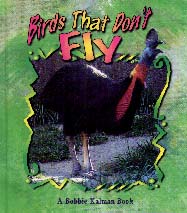|
________________
CM . . . .
Volume V Number 5 . . . . October 30, 1998
excerpt: Many people think that all birds fly, but more than 20 types of birds cannot fly at all! Millions of years ago, most birds flew in order to find food and escape from predators. Predators are animals that hunt other animals. Some birds, however, lived in places with few or no predators. There was plenty of food on the ground or in the water. These birds did not need to fly, so they flew less and less often. Over time, they lost their ability to fly and became flightless birds.Emus, ostriches, rheas, cassowaries and penguins may not be designed for flying, but their bodies have a variety of adaptations necessary for survival. The cassowary has a hard crown that acts as a helmet, the penguin has solid bones for diving, and the ostrich can run up to 64 km per hour. Part of the series, "Birds Up Close," Birds That Don't Fly also examines breeding and nesting, some of the rare flightless birds, and even some that are now extinct. Several of the birds, including rheas and cassowaries, are profiled and have sidebars that include information such as height, weight, habitat and predators. Individual qualities about each species are also included, examples being the kiwi's amazing sense of smell and the emu's nomadic tendencies. The book endeavours to cover a lot of ground and many species within 32 pages, and the text layout is somewhat disjointed. The table of contents and index help, but there are times when the species and facts become jumbled. Although a half page dictionary, "Words to know," helps clarify many of the terms, a more extensive glossary would be useful. The photographs are clear and varied, and there are illustrations of the extinct auk, moa and dodo. In summary, the problems are minor though, and the book introduces some lesser known species of flightless birds. Recommended. Shannon Nesdoly, mother of two, is an education student at the Faculty of Education, University of Manitoba.
To comment on this title or this review, send mail to cm@umanitoba.ca.
Copyright © the Manitoba Library Association.
Reproduction for personal use is permitted only if this copyright notice
is maintained. Any other reproduction is prohibited without
permission.
Published by
TABLE OF CONTENTS FOR THIS ISSUE - OCTOBER 30, 1998.
AUTHORS |
TITLES |
MEDIA REVIEWS |
PROFILES |
BACK ISSUES |
SEARCH |
CMARCHIVE |
HOME
|

